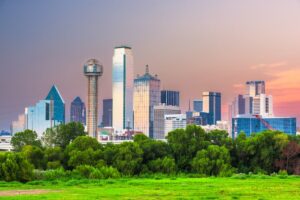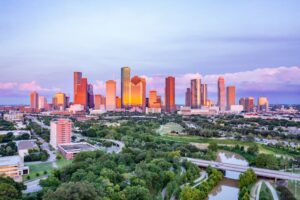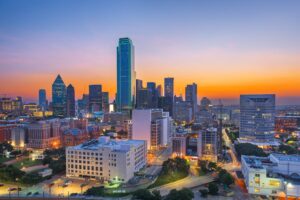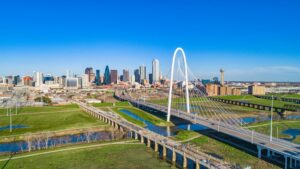
In many parts of the country, renting has become a highly desirable alternative to traditional homeownership. From young professionals to retirees and families of all sizes, there are more and more people renting in lieu of buying. But rather than apartments or condominiums, many people are instead opting for single-family homes for rent. As developers adapt to meet the demands of this real estate market trend (which doesn’t appear to be going anywhere anytime soon), a new type of community has become widely popular: build-to-rent homes.
Designed specifically for long-term renters, build-to-rent communities offer the best of both worlds: the ease of renting and the perks of a single-family home. And when developers create entire master-planned communities of built-to-rent homes, residents are able to live in a neighborhood and home that flawlessly fits their preferences, needs, and lifestyle. Whether you’re interested in renting one of these properties or investing in a build-to-rent community, we’ve created a useful guide to first provide you with everything you need to know.
What is “Build to Rent”?
A build-to-rent home is one that has been built for the purpose of long-term rental. Unlike standard apartments and similar, multi-family structures, build-to-rent homes are specifically intended to be an ideal option for individuals searching for a long-term rental residence (so, several years or more vs. short-term leases). There are several generally interchangeable terms used to refer to properties such as these:
- Build-to-rent homes
- BTR homes
- Build-for-rent (BFR) homes
- B2R homes
Whereas typical communities are developed with prospective buyers in mind, BTR communities are created for long-term tenants. This can factor into the home and property designs and the overall set-up of the community. Often, build-to-rent developments aim for a balance of versatility (to be flexible enough to meet varying residents’ needs) and luxury (to offer an attractive alternative to traditional rental options).
Some build-to-rent homes are situated in professionally managed communities, in contrast to standard homes that a private landlord is renting out. Professional community management can offer plenty of perks for residents, ranging from a beautifully maintained neighborhood, high-end amenities and services, and complimentary landscaping and home maintenance.
It’s important to note that it’s relatively rare for a BTR developer to singularly facilitate design, construction, community development, and property management services – which is one of the qualities that make Wan Bridge communities so unique. BTR homes require specialized development expertise and skill, which is why they are commonly reserved for dedicated build-to-rent developers, like Wan Bridge.
In many cases, the developers operate in partnership with real estate investors, builders, and/or landowners to complete a community from start to finish. Investors can pursue BTR communities as a form of passive income, with the potential for profit particularly impressive in regions where demand is high.
Types Of Build-To-Rent Homes
Build-to-rent homes can take a few different forms, covering a wide range of sizes, styles, and price points. Because there is such extensive variety in the BTR market, it allows for a diverse range of tenants to find options that suit their individual needs. Some of the most common build-to-rent home types include:
- Single-family homes: Many BTR communities appear to be virtually identical to traditional suburban neighborhoods (often with the addition of community amenities). Single-family BTR homes are individual homes, each situated on their own lot.
- Duplexes: A BTR duplex is made up of two residential units that are attached.
- Row homes: A style commonly seen in a city’s urban/downtown areas, BTR row homes are built side-by-side and share a common wall (hence, a “row” of homes).
- Small lot homes: BTR small lot homes are single-family residences that are constructed on smaller-than-typical lots. For example, a typical lot might measure about 5,000 square feet (including the front and back yards), but a small lot might span 600-700 square feet.
Why Are Build-To-Rent Homes Becoming More Popular?
Most housing experts point to the housing market crash of 2007 – and the resulting foreclosure crisis – and a major reason why real estate has seen such a shift. When millions of homes went into foreclosure, real estate investors began purchasing them, completing renovations, and then renting them or reselling for a profit.
What was once a rental market made up of single-family rentals owned by landlords transitioned into a professionally managed category of real estate assets, and it’s been growing rapidly ever since. This change in the rental market is providing benefits for investors, developers, and tenants (more on that in a bit). So, even though it can be surprising to see such a massive change happen over a relatively short period of time, this appears to be a great move overall. So, why do people choose to rent a BTR home versus a typical rental or homeownership? Well, there are many different reasons, often including:
- More value for the monthly rental investment (compared to an individual home for rent)
- Better amenities
- Professionally-managed communities
- Increased stability
- Shifts in generational values and priorities (for example, the millennial generation doesn’t necessarily equate financial success with homeownership, which differs from generations before them)
- Flexibility/mobility
For investors, BTR homes are an appealing option as well. The newly-constructed inventory offers a safer, potentially more profitable option than pre-owned homes. Also, the ability to partner with a BTR developer simplifies the investment experience considerably and allows for fuss-free passive income.
Build-to-Rent Community Development
When an entire neighborhood is developed as a BTR community, there is the opportunity to maximize value, quality of life, and long-term appeal. An experienced build-to-rent developer clearly understands how to plan a BTR community that serves everyone involved: tenants, investors, and other partners. During the development process, this may look like:
- Designing homes that will appeal to tenants, incorporating thoughtful elements such as spacious floorplans and upgraded finishes to stand apart from typical rentals.
- Providing a varied range of home sizes and price points within a community to satisfy a broad range of tenant needs.
- Planning communities that offer unique amenities, including playgrounds, parks, walking trails, waterfront access, and other exclusive benefits for residents to enjoy.
- Pinpointing specific regions/cities in which there is high demand for BTR homes fulfills demand from residents and ensures optimal capacity.
- Working closely with building and supply partners to secure the best-possible construction costs so that savings can be passed along to tenants (and investors’ profits can be ideal).
The process of developing a BTR community varies, both among developers and even from one community to the next. But even though every new community is unique, there are usually a few basic steps involved:
- The developer selects a target area, using real estate data that breaks down demand in that region, current rental options, and other key information. For example, our Palm Bay Galveston rental homes first began when we determined that the Galveston rental market had very few options for high-end, single-family homes – a gap we were ready to fill.
- Land is acquired by the developer. In some cases, this occurs through a partnership with the landowner (and a financial arrangement may be made in which the landowner receives a portion of the profits).
- Various partnerships with investors, builders, and other entities are finalized. Investors might include REITs (real estate investment trusts), which allow individual buyers to purchase a “share” of a real estate as part of their investment portfolios.
- Homes are designed and constructed, and community amenities, landscaping, and other key features are also completed. For example, in our Lakeside Conroe community in Montgomery, that meant incorporating details such as walk-in closets, open-concept living and dining rooms, extra storage, and high-end finishes.
- The BTR homes are made available to rent, a process often managed by the developer.
- After tenants have moved in, a professional property management team handles ongoing community needs and maintenance. As a result, the BTR development is able to sustain its quality, value, and desirability. Wan Bridge is unique in that after a community is complete, we still maintain a presence in the neighborhood through our professional management services. That way, we can ensure that the integrity and overall vision for the community are preserved.
How To Get A Build-To-Rent Home
Once a community is either partially or totally complete (depending on the developer), homes become available to tenants. Applications might take different forms, depending on the administrator. Wan Bridge developments put tenants’ needs front and center, even from the very beginning of the application process. So, we streamlined all steps as much as possible:
- You can check the availability for specific communities, including which homes/floor plans are available for rent.
- Then, you’ll apply online. All documents (such as your proof of income and identification) can be emailed to us, so no need to deal with printing and mailing a stack of papers.
- When the application is complete, all signatures are collected electronically.
- Usually, you’ll hear back from us within 24-48 hours once you’ve verified the necessary documents.
- Once your application has been approved, you’ll pay your deposit to reserve the home of your dreams.
- After you sign the lease, we’ll get your move-in date on the calendar.
- Once you set up utilities and renter’s insurance (if required), you can submit the information directly to the community email.
- Then, all that’s left is for you to move in and enjoy the Wan Bridge way of life!
What Is The BTR Market Like?
According to a recent article published in REALTOR® Magazine, the real estate industry is seeing a considerable increase in BTR development – and demand. And yet, only about 5% of properties are estimated to fall within the BTR category. For developers and investors alike, this means that there has never been a better time to stake their claim in the market niche.
For potential tenants interested in living in a BTR home, the availability of high-quality properties in their area will likely increase steadily… but so will competition in securing homes in desirable communities. Essentially, the key takeaway is this: for investors and potential residents alike, the time to act is now.
Build-to-Rent Homes: The Right Option for You?
Making the decision to rent is often less stressful than choosing to buy a home, but nevertheless, it’s still important to weigh your options. Once you clearly understand the pros and cons of build-to-rent homes, you can decide if it’s the right fit for you.
When you move into a Wan Bridge BTR community, we want you to feel completely confident in your choice. And if you’re a potential investor, we feel that it’s equally important for you to be well-aware of what BTR homes have to offer. So, we’ve put together a detailed list of the benefits and possible drawbacks of renting a BTR home – let’s dive right in.
Benefits Of Build-To-Rent Homes
Here are some of the biggest benefits of living in a BTR community:
No worrying about home maintenance and unexpected repairs
When you buy a home, anything that might go wrong is yours to deal with – and pay for. Add to that all of the ongoing maintenance (yard upkeep, A/C maintenance, painting, etc.), and you can end up spending a lot of time and money. And for renters living in homes owned by private landlords, many of those unwanted chores end up falling on their shoulders, regardless. But when you live in a BTR community built and managed by Wan Bridge, you’re able to enjoy all of the perks of a spacious home without any of the frustration. From a burnt-out lightbulb to grass that needs to be mowed, Wan Bridge takes care of it all for our tenants.
Freedom from the typical costs of homeownership
You might have compared monthly rent vs. mortgage payments, but what about all the other expenses that come with owning a home? Homeowners are responsible for things like property taxes, homeowners’ insurance, HOA fees, and other costs that can quickly add up. For this reason, renting in a BTR community can often end up being the best way to maximize the value of your investment.
High quality of life
BTR homes – specifically those by Wan Bridge – are often built with luxury features, both in the individual homes and the community as a whole. Because many BTR homes are situated in master-planned communities, you’re not just renting a house, you’re getting an entire lifestyle. Our homes offer an unparalleled balance of high-end design, quality construction, and convenience, giving you the freedom to focus on making the most of everyday life.
A sense of community
There’s something special about being a part of a community, and it’s not something you can necessarily find in just any neighborhood. Oftentimes, the amenities in BTR communities (like playgrounds, pools, and parks) create opportunities to build relationships with your neighbors.
Potential Drawbacks of Build-to-Rent Homes
Like any living arrangement, BTR homes come with their own drawbacks – but depending on your priorities, these might not be deal-breakers:
Inability to remodel or make significant changes to the property
For some people, being able to change a home’s core features is an enjoyable part of homeownership (although others might not feel the same way!). Keep in mind that knocking down walls, changing flooring, and building add-ons aren’t usually an option when you’re renting.
Few options for historic homes
Sometimes, people prefer living in older homes, whether it’s for the quirky, historic charm, or another reason. However, most BTR homes are brand-new (or close to it), so if you’re looking for a historic property, this might not be the route for you.
More expensive than some apartments
Although the average rent for a build-to-rent home depends on the area, the property itself, and other factors, it’s not unusual for the price to be somewhat higher than what you’d pay for an apartment. As the old saying goes, you get what you pay for – if you don’t care for amenities, quality, or the size of a property, then a low-priced apartment might be your first choice. But if you’re looking to maximize value, then paying slightly more for a single-family home with amenities is more than likely the right choice.
Investing in a Build-to-Rent Community
Are you considering partnering with Wan Bridge as an investor? As one of the leading BTR developers in Texas and the U.S., we look forward to connecting with potential investors who are interested in joining the BTR movement. Here are some of the potential benefits of investing in a build-to-rent development project:
Easy passive income
Whereas operating as a landlord requires significant effort, being a BTR investor offers a much more “hands-off” approach. It’s an easier way to invest in the rental market and an option that many investors find they prefer.
Less tenant turnover
BTR developments are designed for long-term tenants, whereas apartments are usually intended to appeal to temporary renters. So, there is generally more security in the BTR market because tenant turnover is far lower.
Participation in an already-existing, proven model
Any kind of investment can feel like a gamble, but the BTR market is often considered a pretty safe bet. When you work with Wan Bridge, you have the confidence of knowing that we already have more than a dozen successful BTR communities under our belt (and counting). We know what works and what doesn’t, so you don’t have to learn from costly mistakes along the way.
Wan Bridge: A Leader in Build-to-Rent Communities
Wan Bridge is proud to be a leader in the BTR movement, and we’re committed to elevating expectations for build-to-rent communities in Texas and the U.S. as a whole.
As one of the few developers that seamlessly transitions from designer to builders, to professional property manager, we ensure that every community’s integrity is carefully preserved – and your investment is protected from the risks and expenses associated with mismanagement.
Learn More about What BTR Could Mean for You
Whether you’re considering renting or investing in a BTR community, Wan Bridge is here to help you get the answers you need. At present, we have more than a dozen communities of rental homes in Texas, including in-demand developments in Houston, Forney, Rosharon, Kingwood, League City, Galveston, and several other cities.
And going forward, you can look forward to many more Wan Bridge developments to come. Feel free to reach out to our team today for more information about our homes for rent in Texas, future developments, and more.
Image Source: Studio Romantic / Shutterstock






